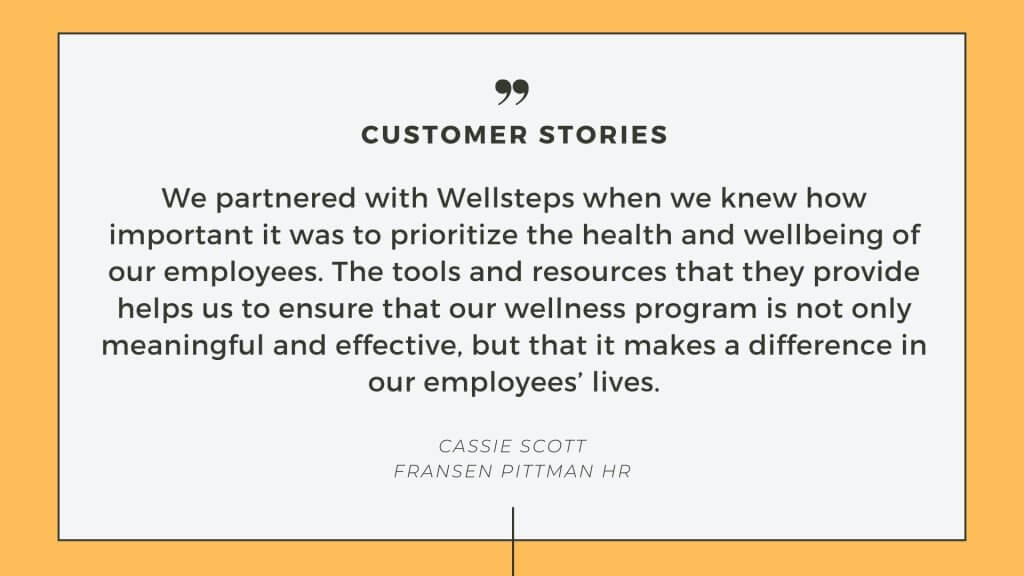Having wellness programs that keep employees engaged can significantly improve employee retention. When employees have a positive well-being—physically, emotionally, financially, socially, and mentally—there is contentment, security, and stability.
The absence of a nurturing work environment could lead to dissatisfaction and a lack of drive among employees. Well-being at work needs to be promoted as part of the culture in order to keep employee motivation and happiness high. Otherwise, you could lose your best employees not because of what you do to them, but because of what you fail to do for them when it comes to caring for their wellness.

Employees can discern when the company values them enough and wants to keep them for good or when there’s nothing but apathy. They can sense when connections are simply transactional and not relational.
Right and Wrong Ways to Improve Employee Retention
When a company simply compensates the employees’ output and neglects to support their growth and aspirations, workers begin to feel dispensable and less valuable. They lose interest in their job and look elsewhere for a better, more nurturing environment.
Some of these wellness programs that raise employees’ satisfaction meters are:
- Stress management and relaxation activities
- Mandatory lunch breaks and coffee breaks
- Healthy food options
- Fitness activities
- Flexible work hours
- Clean and safe work spaces
- Training programs
- Career advancement opportunities
- Financial rewards
- Team building programs
- Clubs and social activities
RELATED: 18 Corporate Wellness Ideas and Wellness Activities
Improving Employee Retention Through Genuine Care
Wellness programs that cater to the holistic needs of the employees provide them with good reasons to stay committed to the company. When your workforce feels cared for, they form a stronger bond with their employers. Conversely, when their wellbeing needs are not addressed, they feel detached and begin to lose commitment.
Having wellness programs in place is a win-win strategy for companies, as it makes perfect sense to take care of the people who take care of their operations.

Having wellness programs in place is a win-win strategy for companies, as it makes perfect sense to take care of the people who take care of their operations. A lack of good wellness programs is like having a house that feels empty and cold. Residents eventually leave and settle in a place where they can flourish and find a place they can call home.
Here are some of the ways company wellness programs improve employee retention.
They Demonstrate Importance Given to Employees’ Well-Being
Words not backed by action are meaningless. No matter how well-meant your corporate message is about valuing your employees, it will fail to connect if it is not translated into actual practice.
Concrete, consistent, and results-oriented wellness programs that reach out, support, follow up, assess, and appreciate employee participation are a testament of the company’s commitment to caring for its people.
When employees know that their well-being matters to the bosses, they show appreciation through commitment and loyalty. They are infused with a dose of energy that they pour into their work.
A holistic wellness approach that supports their overall well-being goes a long way. Employees feel happier, healthier, more engaged, and more committed to their company.
They Promote Health and Wellness of Employees
Wellness programs that promote a healthy lifestyle help employees improve their physical and mental condition and reduce health risks. Some employees with health issues may not be able to perform at full capacity when they feel weak and depressed, and may be left with no choice but to leave the company because of these limitations.
When employees’ healthcare is supported, sick leaves and health insurance costs are reduced. Employees become less prone to illnesses, and they have more energy to do their work for longer years.
Without support for their wellness needs, employees lose their drive to work, feel lethargic and unable to perform challenging tasks, and begin to think about looking for a better work environment where they can thrive.

Employees perform their best when they’re in a space that is conducive to their well-being and development as human beings.
RELATED: How Effective Workplace Health Programs Reduce Health Care Costs
They Increase Employee Satisfaction
Wellness programs that meet employee needs increase their satisfaction levels. Programs can turn negative signs of dissatisfied employees around in ways such as:
- From distraction to greater focus
- From sluggishness and procrastination to energy and enthusiasm
- From frequent leaves and absences to less absenteeism and deeper involvement
- From low productivity level to higher work output, even exceeding targets
- From negative behavior like irritability and complaining to more patience and cooperation
Dissatisfied employees tend to dissociate. Without wellness programs to tether them to the company, they could easily quit and leave without hesitation.
Wellness programs that support and satisfy their needs can draw them closer to the company. Employees don’t see a reason to leave a place where they are content and nurtured by a caring hand.
Being satisfied with their job does not mean everything in the workplace is perfect and faultless. However, when employees enjoy work-life balance and feel good about themselves, they become more tolerant and are better able to handle stress and challenges.
Constantly nurturing the pasture of the workplace makes it a nourishing and gratifying ground where employees can flourish and stay rooted.
RELATED: How Wellness Programs Help Improve Employee Morale
They Boost Employee Loyalty
As in any relationship, loyalty is earned, not demanded. In the work environment, how you take care of your employees’ wellness will shape their perception of your company and influence their level of loyalty.
According to research by Optum, employers with programs that promote workforce wellness are perceived positively by their employees. Employees feel proud to be part of the company and are likely to recommend it as a good place to work.
Incentivizing loyalty as part of a wellness program is a sound and proactive way to improve employee retention in the company. It gives employees something to look forward to as they dedicate years of work to the organization and contribute to its growth over time.

Some of the ways you can improve employee loyalty include:
- Employee recognition programs
- Milestone awards and financial rewards
- Eligibility for company scholarship programs
- Elite circle of long-term and accomplished employees
- Expanded role and moving up based on tenure
Making it worth their while to stay long in the company is a good way to improve employee retention. These measures should be appealing to them, measurable, sustainable, and rewarding. Loyalty programs that are well-designed and implemented can add value to their growth goals and align them with corporate priorities.
RELATED: Best Employee Retention Strategies to Reduce Labor Loss and Increase Loyalty
They Reduce Stress and Anxiety, Key Way to Improve Employee Retention
Stress and tension at work come with the territory, but it doesn’t have to mean letting a toxic work environment become the norm. People who work in a “crunch culture” feel strained and suffocated, which can lead to burnout and quitting.
Working in a perpetually stressful environment could negatively affect their mental, physical, and emotional well-being. Exposure to wear and tear of this kind can adversely affect employees’ health and attitude towards their job. When the weight is too much, the response will either be fight or flight.
Wellness programs that strengthen the mind, body, and emotions help the workforce manage stress better and find their center and flow. Providing employees with some haven amid the hustle can help enhance work performance and improve employee retention.
Promoting work-life balance must be systemic and not simply a section in the company’s employee retention initiatives.
Promoting work-life balance must be systemic and not simply a section in the company’s employee retention initiatives. It has to be the overarching goal across all the wellness programs of the company. When these programs and activities are geared towards providing this balance, all parties benefit: the employees, the company, the customers, and other stakeholders.

They Promote Teamwork
Group wellness activities foster teamwork and a collaborative, inclusive culture where everyone feels the value of their role in the organization. Having a support group, wellness club, shared interest activities, and social circles in the workplace infuses a reinforcing and harmonious ambience, weaving strong connections.
When there is strong teamwork:
- projects are managed better
- messages are more effectively channeled
- targets are achieved more easily
- everyone feels a sense of value for their contribution to the group’s success
This positive chain of effects helps improve employee retention because there is no reason to quit when you’re winning.
Furthermore, it also cultivates healthy competition within the organization. This can motivate teams and departments to step up and synergize their abilities. It also gives employees an additional avenue for getting involved and actively contributing to team effort. Everyone in the team supports each other to keep the whole group competitive, and this benefits the company as a whole.
RELATED: 16 Staff Wellness Activities for Creating a Healthier Workplace
They Increase Employee Engagement
Wellness programs are intended to engage employees and help provide solutions to their holistic needs. These activities therefore need to be interesting, practical, sustainable, viable, and measurable to improve employee retention effectively.
When employees actively participate in company-sponsored activities and are invested in their roles, they become more attached to the company and identify with its mission and values in a deeper way.

To help retain employees, employee engagement strategies should be:
- Realistic. Set attainable objectives within your resource parameters.
- Well-delegated roles. Assign responsibilities to the key facilitators and managers for accountability.
- With immediate feedback. Immediate reactions regarding the activity should be communicated to better assess the effectivity of the program.
Employee engagement is an indicator of employees’ enthusiasm toward the company’s wellness programs. Engaged employees are more inclined to stay with the company because of their sustained interest and participation.
Employee engagement is an indicator of employees’ enthusiasm toward the company’s wellness programs.
They Show Investment in Employees – Our Favorite Way to Improve Employee Retention
Investing in your company’s best asset, your workforce, is a sound business policy because all parties reap benefits. Wellness programs are employee-care in action that go beyond platitudes and promises. Investing in the growth and well-being of your employees’ minds, bodies, and spirits lifts their employee morale and helps to improve employee retention too.
As a result, they become more engaged and invested in the company, and they are motivated to contribute to the team. They see opportunities for a better future in the company as they:
- receive training and learning programs
- healthcare support
- emotional support
- a strong professional network
- a venue for continuous growth as individuals
Conversely, employees who do not enjoy company-sponsored wellness programs tend to feel undervalued and disengaged. Wellness programs and a work environment that supports employees make working more fun and exciting because employees have something to look forward to.
Employees who are happy with the way their company supports their well-being do not feel the need to change their work circumstances and are likely to stay for the long haul.
RELATED: Employee Health Programs Worth Investing In
They Reduce Healthcare Expenses
According to the CDC, or Centers for Disease Control and Prevention, promoting health maintenance and mitigation of risk factors like smoking, diabetes, hypertension, and weight problems can lead to significantly lower costs of healthcare and insurance claims. Well-implemented healthcare programs also deliver a 25% savings on employees’ absenteeism, compensation, and disability and medical care costs.
Wellness programs that support a healthy lifestyle are a good way to improve employee retention because healthy employees are not susceptible to frailties, sickness, and early retirement.

Overwork can put employees’ health at risk and reduce their energy and motivation to deliver quality output. Employee wellness programs are good ways to counter the adverse effects of work-related stress and weariness, with resources such as:
- healthy lifestyle coaching
- smoking cessation programs
- weight management programs
- physical fitness activities
Having healthcare programs makes employees feel cared for, which has a direct effect on their satisfaction.
RELATED: This Is the Impact of Employee Wellness Programs on Health Care Costs
They Promote Better Work Relationships
A nurturing and caring work environment creates open, balanced, and supportive relationships that make working more fun and motivating. This helps to improve employee retention as well.
“Whoever is happy will make others happy, too.” – Anne Frank
Getting support from the boss and colleagues allows for a more joyful and fulfilling experience in the workplace. Having well-implemented wellness programs fosters work relationships that result in better employee performance. Activities and programs like the following help nurture camaraderie and support among employees.
- coaching and training
- team walks
- yoga classes
- clubs
- team-building activities
- collaborative projects
Cultivating good relationships in the workplace through wellness programs reduces stress and disagreements, and minimizes employee attrition. It also promotes a good flow of ideas, support, teamwork, and efficiency in achieving objectives.
RELATED: 9 Workplace Well-Being Activities to Skyrocket Employee Productivity
Final Thoughts on How to Improve Employee Retention
When it comes to caring for employees and gaining their loyalty, creating wellness programs that invest in their growth and development is the way to go. There is no shortcut to earning employee loyalty and to improve employee retention.
The company needs to put in the work to be an effective architect of a work-life balance that is strong, nurturing, and deserving of loyalty.
Wellness programs may cost the company money, time, and energy, but having to constantly hire and onboard new employees to fill vacated positions can cost even more beyond money. A high attrition rate reduces the sense of solidity and disrupts workflows, making the company less attractive to jobseekers and enjoyable to existing employees. Ultimately, it negatively reflects the company’s leadership and trustworthiness.
The company needs to put in the work to be an effective architect of a work-life balance that is strong, nurturing, and deserving of loyalty.
Wellness programs are necessary for companies to strengthen their workforce, develop employees as well-rounded talents, and enjoy the benefit of having optimally performing workers who have a sound mind, body, and disposition.
We invite you to enjoy a free demo with our Wellsteps team and discover exactly how we can help you put your company’s wellness program together and enjoy all the benefits we’ve discussed today.
